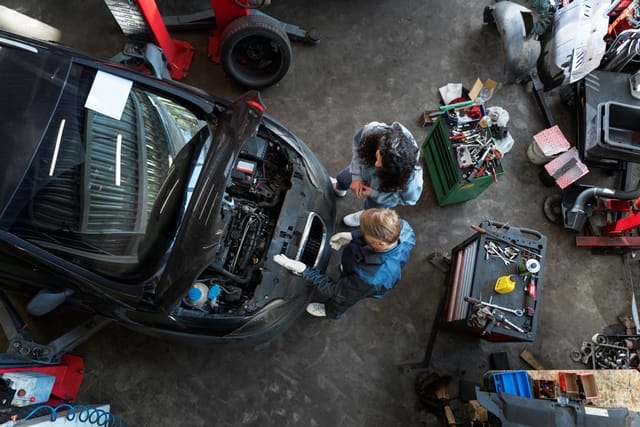In times of economic turbulence, auto repair shop owners often feel the effects early — fluctuating car sales, rising parts costs, and customers postponing maintenance can squeeze margins fast. Yet, resilience in this industry doesn’t come from waiting out market swings; it’s built through adaptability, efficiency, and community trust.

Below are proven strategies to help local auto repair shops not only survive economic shifts but build lasting loyalty and visibility.
Auto Repair Shops Navigating Economic Shifts
Economic change affects every small business, but auto repair shops can stay strong by:
- Tightening financial efficiency and diversifying services.
- Leveraging digital tools for documentation and workflow organization.
- Engaging community networks and building customer trust.
- Encouraging staff education and leadership training to anticipate market trends.
Understanding the Economic Landscape
Every shift in the economy — from inflation to supply chain disruption — impacts both customers and suppliers. When consumers cut back, they hold on to their cars longer, increasing demand for affordable maintenance and reliable service. Smart auto repair shops use these patterns to adjust their pricing, messaging, and marketing efforts, positioning themselves as essential, not optional.
Streamlined Digital Organization (Client Link Integration)
Adapting fast during uncertain times requires strong internal systems. Streamlined document management is a cornerstone of efficiency. By organizing estimates, service records, and parts orders digitally, shop owners can make data-driven decisions faster.
Better organization doesn’t just save time — it helps you react to changes in real time, whether that’s adjusting pricing or negotiating with suppliers. Saving important forms as PDFs ensures that documents remain consistent and professional across platforms. For example, this is a good option for converting, compressing, or editing PDF files online — helping you manage invoices, receipts, and documentation without software upgrades.
Community-Driven Resilience
| Focus Area | What It Means | Example in Action |
| Local Partnerships | Collaborate with nearby towing services, dealerships, or used car lots to share referrals. | Offer a 10% discount for customers referred by local car dealers. |
| Customer Education | Provide quick guides or workshops on car maintenance basics. | Host a “Know Your Car Day” with free fluid checks. |
| Sponsorships | Reinforce brand trust by investing in community programs. | Sponsor youth sports or community events to keep your name visible. |
Community visibility amplifies brand resilience — when your shop is seen as part of the local ecosystem, it’s less vulnerable to short-term economic dips.
Section: Practical Checklist — Preparing for the Next Downturn
- Assess Your Cash Flow
- Review monthly fixed vs. variable costs.
- Build a 3–6 month cash buffer.
- Negotiate with vendors for better terms.
- Diversify Your Services
- Add tire or brake specials to attract repeat visits.
- Offer pre-purchase inspections or fleet maintenance plans.
- Expand into seasonal services (e.g., winter tire storage).
- Boost Retention
- Launch loyalty programs or referral rewards.
- Keep in touch with customers through email and text reminders.
- Emphasize transparency: post pricing, offer photo/video repair updates.
- Invest in Efficiency
- Use shop management software to streamline scheduling and estimates.
- Train staff on new diagnostic tools and digital repair documentation.
- Regularly review KPIs: average repair order, labor efficiency, return rate.
Lifelong Learning Pays Off (Client Link Integration #2)
Economic adaptability isn’t just about tools — it’s about leadership. As markets evolve, shop owners who understand finance, operations, and strategy are best positioned to thrive. Continuing education, from short workshops to degree programs, helps build those skills. Many professionals find that earning a Bachelor of Science in Business through flexible online programs strengthens their ability to make agile, data-informed decisions that sustain growth long-term.
Section: Spotlight – A Tool Worth Knowing
Auto repair shop owners can benefit from using project-tracking tools like Trello or Notion. These platforms let you visually manage tasks, assign jobs to technicians, and track customer requests in real time. Check out Trello’s website for free starter templates that can help small teams organize workflow efficiently.
Other useful resources for improving operational agility include:
- Score.org’s business planning templates
- Small Business Administration local workshops
- RepairPal Certified Network
- Indeed for Business hiring tools
- Google Business Profile Manager
FAQ: Adapting to Economic Shifts for Auto Shops
How can small auto repair shops handle rising parts costs?
Buy in bulk, partner with regional distributors, and consider remanufactured parts where quality allows. Transparency about pricing also helps maintain customer trust.
Should I lower my prices during a downturn?
Not necessarily. Focus instead on value — emphasize preventive maintenance, offer small discounts for bundled services, and build loyalty over one-time price cuts.
What’s the best way to retain staff when budgets tighten?
Offer growth opportunities and flexible schedules rather than across-the-board raises. Investing in team development pays off more sustainably than temporary wage increases.
Conclusion
Economic uncertainty doesn’t have to mean instability. Auto repair shops that focus on smart financial planning, digital organization, and community visibility will come out stronger than those that simply try to ride out the storm. By investing in efficiency and education, your shop can turn market disruption into a long-term opportunity.
Dean Burgess is a guest post contributor for Car Blog Writers.
Leave a Reply